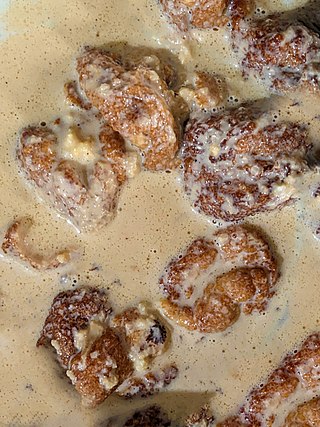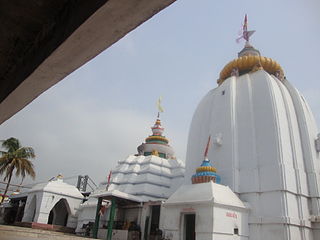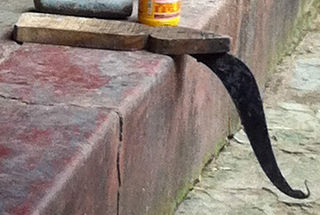Related Research Articles
Kalinga is a historical region of India. It is generally defined as the eastern coastal region between the Ganges and the Godavari rivers, although its boundaries have fluctuated with the territory of its rulers. The core territory of Kalinga now encompasses all of Odisha and some part of northern Andhra Pradesh. At its widest extent, the Kalinga region also included parts of present-day Chhattisgarh, extending up to Amarkantak in the west. In the ancient period it extended until the bank of the Ganges river.

Dhenkanal State was one of the princely states of India during the period of the British Raj. The state is now referred to as Dhenkanal district, Odisha, with Dhenkanal town as its district headquarters.

The history of Odisha begins in the Lower Paleolithic era, as Acheulian tools dating to the period have been discovered in various places in the region. The early history of Odisha can be traced back to writings found in ancient texts like the Mahabharata, Maha Govinda Sutta and some Puranas. The region was also known to other kingdoms in region of East Indies due to maritime trade relations.

Rasabali is a sweet dish from Odisha, India. Rasabali is offered to Baladevjew, and originated in the Baladevjew Temple of Kendrapara. It is one of the Chapana bhoga of Jagannath temple. Kendrapara's Rasabali got GI tag on 3 October 2023.

The Eastern Ganga dynasty were a large medieval era Indian royal Hindu dynasty that reigned from Kalinga from as early as the 5th century to the mid 20th century. Eastern Gangas ruled much of the modern region of Odisha in three different phases by the passage of time, known as Early Eastern Gangas (493–1077), Imperial Eastern Gangas (1077–1436) and Khemundi Gangas (1436–1947). They are known as "Eastern Gangas" to distinguish them from the Western Gangas who ruled over Karnataka. The territory ruled by the dynasty consisted of the whole of the modern-day Indian state of Odisha, as well as major parts of north Andhra Pradesh, parts of Chhattisgarh and some southern districts of West Bengal. Odia language got official status in their regime following the evolution of the language from Odra Prakrit. The early rulers of the dynasty ruled from Dantapuram; the capital was later moved to Kalinganagara, and ultimately to Kataka and then to Paralakhemundi.

Enduri pitha, also known as Haldi patra pitha, is a variety of pitha made in the Indian state of Odisha mostly in the northern, eastern and central region. Ingredients are turmeric leaves, black gram, rice flour, coconut or Chhena, jaggery, black pepper. Enduri is mostly prepared during Prathamastami and Manabasa Gurubara. It is a light snack and has laxative effect because of the turmeric leaves that are used to wrap the pitha. Traditionally, enduri used to be made by steaming in large earthen pots. Enduri is one of the many other pithas offered to Jagannath in the Jagannath Temple, Puri for "Sakala dhupa" (breakfast).

Dhabaleswar Temple is dedicated to the worship of Lord Shiva. It is situated at a distance of 27 km from the city of Cuttack, Odisha, India, on the riverine island of Lord Dhabaleshwar. The temple, located on an island on River Mahanadi, is embellished with stone carvings that date back to the early 10th and 11th century. The serene ambiance, in which the temple is situated, inspires spiritual feeling among one and all.

Poda pitha is slow-cooked pitha. It is made by slowly baking fermented rice, black gram, grated coconut and jaggery overnight. Its crust is slightly burnt, while the inside is soft and white. Poda pitha is generally made during Raja Parba. It is served to Lord Jagannath and his siblings at Mausi Maa Temple on their way back after Ratha-Yatra, from Gundicha Temple to Jagannath Temple, Puri.

Paniki is a traditional East Indian tool with a cutting edge with a wooden footrest. Panikis are used in the kitchen for chopping vegetables, fish and meat. Panikis are mostly found in Odisha, India and the variations of the tool is known as Boti in West Bengal and Tripura in India and in Bangladesh. Various tribes of Odisha used for different purposes. The tribe members of the Mutkia Kondha worship paniki as deity and do not keep their feet with their feet. They rather use a special type of paniki with a wooden stand. Panikis of ancient times show engraving of cultural and religious elements. Traditionally in rural Odisha, panikis are made from wrought iron or recycled steel by the blacksmith.
Gouranga Charan Das (1899–1972) was a Gandhian freedom fighter, and leader of the socialist Kissan Movement and Gadajat Praja Andolon in Odisha. He was a renowned personality in British India.
Aul is a town and the headquarters of Aul CD Block and Aul Tehsil in Kendrapara district in the Indian state of Odisha. It is 17 km from Chandabali. Aul is surrounded by the river Kharasrota and Brahmani on north and south respectively. To its east is Bhitarkanika National Park.
Vishwanath Dev Gajapati was the king of Kalinga who established a kingdom in the region of Odisha and Andhra Pradesh, historically known as Kalinga. He belonged to the Shankara dynasty that was installed in the region by his great-grandfather Vinayaka Dev and his wife Lilavati. The Silavamsa king Pratap Ganga Raja died without any male heir, only leaving behind his wife and daughter Lilavati. Vinayak Dev who migrated from Jammu or Kashmir after praying to Kashi Vishwanath married Lilavati. Accordingly, the dynasty was called Shankara dynasty. Vinayak Dev also claimed to belong to the legendary Solar dynasty or Suryavansh.

The Bhoi dynasty or the Yaduvamsa dynasty were a medieval Hindu dynasty from the Indian subcontinent, which originated in the region of Odisha that reigned from 1541 to 1560 CE. Govinda Vidyadhara had usurped the throne from the later weaker Suryavamsa Gajapati Empire rulers as the kingdom started weakening but had a short-lived reign as ruling chiefs of Odisha as the ensuing internal rivalries and constant threats of invasions rendered them weak and were eventually overthrown by Mukunda Deva of Chalukya dynasty in 1560.
Aswini Kumar Ghose was an Indian dramatist from Odisha. He is known in Odia literature for his historical plays written in the Odia language based on various Indian historical personalities such as Kalapahad and Tipu Sultan.
Gajapati Rāmachandra Deva I (1568); popularly called Abhinava Indradyumna) was the founder of the Bhoi dynasty of Khurda in Odisha, India. He became the ruler of Khurda kingdom after defeating Mukunda Deva in 1568. He claimed descent from the Yaduvanshi dynasty which features prominenetly in the Indian epic, Mahabharata. The Odia populace gave him the title of "Thakura Raja" as a mark of respect for renovating the damaged Hindu temples that were destroyed by the invasion of Kalapahad. He was titled as Vira Sri Gajapati Viradhi Viravara Pratapi Ramachandra Deva. He was killed by the Karrani Bengal forces during their conquest of Orissa in 1568.
The Puri Estate was an estate ruled by the main branch of the Bhoi dynasty, who were reinstated in Puri in 1809 following the 1804 rebellion against the British and annexation of the Khurda Kingdom which were under their control. After the rebellion led by the Khurda king, Mukunda Deva II, the British decided to take control of the administration of the Khurda kingdom and Mukunda Deva II was exiled to Cuttack and Mindapore but was later reinstated and pensioned off to Puri to remain as a titular head of the dynasty while retaining control over the Jagannath Temple.
Birakishore Das, popularly known as "Jatiya KabiBirakishore" was a poet, social activist and politician from Odisha. Best known for the editor of " Mo Desha" a monthly magazine.

Kalicharan Pattnaik also known by his sobriquet Kabichandra was an eminent literary and artistic figure of Odisha. He had contributions in the field of Odissi music, Odissi dance and Odia theatre. He had significant contributions to development early Odia cinema as well. He was born on 23 December 1898 in the then princely state of Badamba. His compositions in various traditional ragas are widely sung in the field of Odissi music and dance.
The Bengal sultanate conquest of Orissa in 1568 was a military campaign led by the Karrani dynasty of the Bengal Sultanate under Sulaiman Khan Karrani. The objective was to overthrow the Chalukyan rule of Orissa under Mukunda Deva and the Bhoi rule under Ramachandra Deva I. The Bengal forces achieved victory, resulting in the annexation of Odisha into the Sultanate. Odisha remained part of the Bengal Sultanate until its eventual annexation by the Mughal Empire.
References
- ↑ Suryanarayan Das (2010). Lord Jagannath. Sanbun Publishers. pp. 53–. ISBN 978-93-80213-22-4.
- ↑ Cultural Heritage of [Orissa]: pts. 1-2. Katak. State Level Vyasakabi Fakir Mohan Smruti Samsad. 2002. ISBN 978-81-902761-5-3.
- ↑ Journal of the Institute of Asian Studies. The Institute. 1992.
- 1 2 Durga Prasad Patnaik (1989). Palm Leaf Etchings of Orissa. Abhinav Publications. pp. 4–. ISBN 978-81-7017-248-2.
- ↑ India), Asiatic Society (Kolkata (1901). Journal.
- 1 2 S. C. Bhatt, Gopal K. Bhargava (2006). Land and People of Indian States and Union Territories: In 36 Volumes. Orissa. Gyan Publishing House. pp. 26–. ISBN 978-81-7835-377-7.
- ↑ Cultural Heritage of [Orissa]: pts. 1-2. Katak. State Level Vyasakabi Fakir Mohan Smruti Samsad. 2002. ISBN 978-81-902761-5-3.
- ↑ N. K. Sahu (1981). History of Orissa. Nalanda.
- ↑ Arihant Experts (4 June 2019). Know Your State Odisha. Arihant Publications India limited. pp. 24–. ISBN 978-93-131-9327-2.
- ↑ Shyam Sunder Tripathy (1988). Buddhism and Other Religious Cults of South-east India. Sundeep Prakashan. ISBN 978-81-85067-15-5.
- ↑ Suryanarayan Das (2010). Lord Jagannath. Sanbun Publishers. pp. 53–54–. ISBN 978-93-80213-22-4.
- ↑ Crafts and Commerce in Orissa. Mittal Publications. pp. 21–. GGKEY:4EYA3F6QHL9.
- ↑ Orissa General Knowledge. Bright Publications. pp. 27–. ISBN 978-81-7199-574-5.
- ↑ Mohammed Yamin. Impact of Islam on Orissan Culture. Readworthy. pp. 37–. ISBN 978-93-5018-102-7.